
|   |

|   |
SPIC MACAY’s 1st International Convention Text & pics: Veejay Sai e-mail: vs.veejaysai@gmail.com June 5, 2013 SPIC MACAY has grown from strength to strength in the last thirty five years and their recently held 1st international convention was a solid proof of their soaring graph. 20th to 26th of May isn’t the best time of the year to be in a city like Kolkata. With increasing mercury levels and the city’s signature humidity embracing you, the city becomes a nightmare to live in, even for its locals, forget visitors and tourists. But in the middle of the unbearable summers, over two thousand participants cheerfully descended into the cozy comfort of the prestigious IIM campus on the outskirts of the city. From Pakistan to Poland, Afghanistan to Bangladesh, a cross-section of the students came from various chapters of SPIC MACAY (SM) from across the world. For a week, we could have all been in another paradise, if we were to ignore the weather. In fact, eventually the weather stopped being a bother to everyone there once we got immersed in the long tirade of activities that SM offered. Looking specifically at the dance segment, this year was much more than expected! A true delight for the participants who arrived to take part in and get trained under so many legendary dance gurus. New bonds were forged and a whole lot of students opened their minds to the world of Indian dance with a fresh mind. Performances 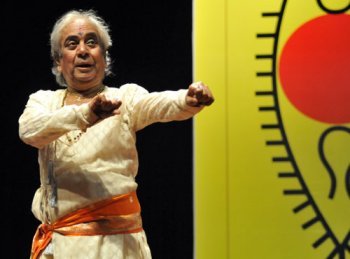 Pt Birju Maharaj (Photo: R. Sreenivasan) 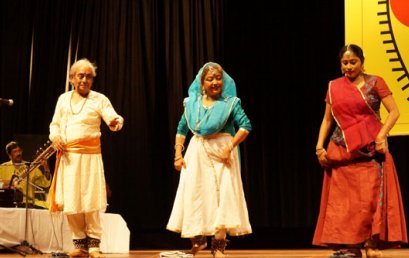 Pt Birju Maharaj, Saswati Sen & Luna Poddar After the main inaugural session by the Governor of West Bengal (now Poschim Bongo), a mellifluous Shehnai recital by Ustad Ali Ahmad Hussain followed. The raag Shuddha Sarang set the right kind of ambience for the next show. This year, the dance segment seemed visibly less in terms of the performances in the main slots. The only major performance that was scheduled to take place (which all of us were eagerly looking out for) was the jugalbandi between Pandit Birju Maharaj and Thumri queen Girija Devi. Her ill health didn’t permit her to perform and what the audience got was a Kathak solo by Majaraj ji. Of course, which performance of Maharaj ji these days is complete without a solo by Saswati Sen. With Shubhankar Bannerjee (easily one of the finest we have today from the Bengal school) on the tabla, Maharaj ji easily danced his way into the hearts of many present. Sashwati Sen opened with ‘Nand Yashoda vaari jaaye, jai jai Radhe Krishna hare’ which turned out to be more of a lec-dem than a performance. Added to that was the increasing decibels of the vocalist’s singing. This was followed by a ‘Dhamaar’ presented by Luna Poddar who hails from Kolkata. She presented ‘Baajat taal dhamaar niratat’, a composition of Pt Birju Maharaj. These two performances started a wee bit of restlessness in the hall as everyone was eagerly waiting for Maharaj ji to arrive. He did and how! Presenting a teentaal composition, using the percussion beats of Shubhankar’s tabla to depict the hero and his own footwork to show the shy nayika, Maharaj ji earned a huge applause from the house. Towards the end of the performance Saswati also saw it as a right opportunity to launch her book, a biography of her guru Pt Birju Maharaj. To receive the first copy were Dr. Kiran Seth and Bharatanatyam guru Chitra Visweswaran. As the evening continued, the inaugural session of the international convention spelled success. Yes! The jugalbandi between the two legends was sorely missed by many who came expecting it. Afternoon buffets 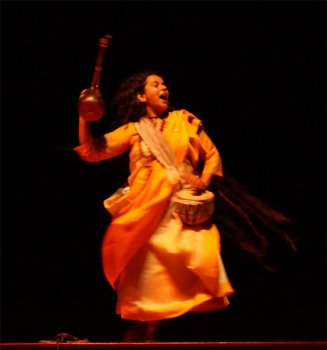
Parvathy Baul
The next day afternoon session was a double-bill for everyone assembled in the auditorium. The opening saw a soul-stirring performance by Baul music exponent Parvathy Baul. Dressed in ocher robes, with her long ankle-length matted locks, a duggi attached to her waist on the left side and an ektara in her right hand, as Parvathy sang the mystic songs of the wandering minstrels of Bengal, a whole hall sat in pin drop silence, in awe of the performance she gave. The very stage exuded a serene positive energy and by the end of her concert, many a teary-eyed audience wanted more of her mystic songs. Parvathy is a highly elevated soul and her songs are not just any other songs. They are mini-performances of brightness on their own. There is music, there is dance and there is that wee bit of theatrical element when she gets into a mystic twirl, like the Sufi dervishes do. From the compositions of Gosai Govinda Chand and Lalan Faqir to the deep philosophy of Sahaj Yoga, Parvathy patiently explained the underlying philosophy with much grace and charm to all the students whose admiration she won. Her final song ‘Hari Khel che se hori, sathi radha pyaari’, describing the scene of Holi in Brindavan had everyone clapping and wanting more of her performance. Parvathy Baul’s music is therapeutic and is much-needed for today’s troubled times. One must thank SPIC MACAY for giving such a pristine experience. Those eyes! The afternoon only got better with a Koodiyattam performance of Kapila Venu. Presenting ‘Sita Parityagam’ or the ‘Abandonment of Sita’, Kapila spread out a virtual buffet of navarasas on the stage. Two eyes weren’t enough to see her perform. With her mask-like face glowing with the light of a lamp, one felt a divine being had descended on the stage. With the melodic mizhavu keeping a strict tab of every move in the background, the story, an interpretative excerpt from Kalidasa’s ‘Raghuvamsam’ unfolded. As the story of Sita progressed, it was impossible to believe that all the various characters could be present in one artiste. Sita, Rama, their children Lava, Kusa and others made their entries and exits just as smooth with a subtle gesture of a hand or a jerk of the shoulder. One just needed to look at Kapila’s eyes throughout the performance. It wasn’t too long before the whole hall drowned in their charm and her narrative prowess took each and every rasika by storm. Each one in the hall felt she was telling the story only to them. There were scenes that made you feel a lump in your throat as you tried hard to withhold your tears back. There were other scenes where each of the characters spoke to you. With sudden bursts of poetic monologues, the whole performance elevated the hall to a different level. Amidst all the cacophony of the drums building into the crescendo, Kapila brought in that much needed stillness. Everyone who wants to know why the UNESCO declared Koodiyattam as “an intangible heritage of mankind” must watch Kapila Venu perform it at least once in their lifetime. She makes you fall in love with the art form.  Kapila Venu 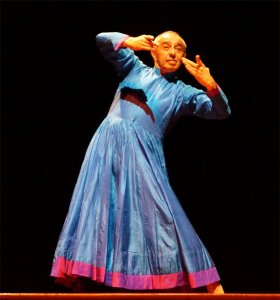 Astad Deboo Another afternoon session had a tailor-made performance by contemporary dance guru Astad Deboo and Dhrupad exponent Ustad Bahauddin Mohiuddin Dagar on his Rudra Veena. How lucky were these participants to witness this wonderful feat! A feast for the senses stretched out as the Ustad played Raag Megh and one saw Astad gracefully twirl, with his arms extended out like the clouds in the sky. The brain couldn’t decide if it was being seduced by the Ustad’s mellifluous Veena or the various rhythmic patterns Astad created on stage. 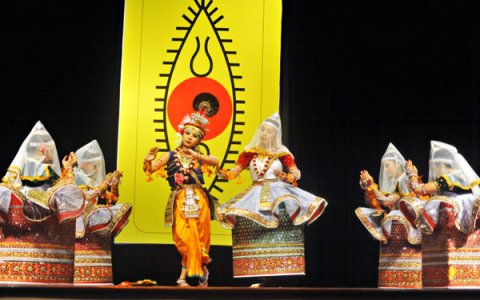 Raas Sankirtan (Photo: R. Sreenivasan) The Raas Sankirtan from Manipur under the guidance of Guru Thanil Singh and Guru Tiken Singh gave an elaborate performance of the traditional Nupipala rituals. After that was the most dreamy-eyed Vasant Raas one could have seen. The lead singer Praneshwori Devi has a voice that can evoke the most sensuous of emotions on a hot summer day. She transported all of us into the land of Radha and Krishna. Watching the Manipuri dancers glide in their traditional costumes, one couldn’t help but fall in love with them. It was a sheer joy to listen to selections from Jayadeva’s ‘Geeta Govindam’ rendered in the Raas sankirtan style. As Anita Thoibi Devi and Monika Devi danced as Krishna and Radha respectively with the four gopis gliding around them, one couldn’t help but sit back and stay stunned with their perfect grace. Towards the end of the performance, as they finally gave an aarti to the dancers frozen in a mural of Radha-Krishna, the whole hall stood up in ovation with folded hands to experience that divine upsurge. 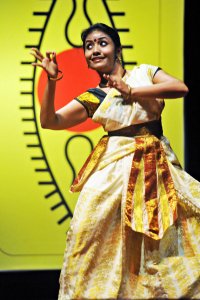 Anwesa Mahanta (Photo: R. Sreenivasan) Yet another afternoon, a series of quick lec-dems replaced the concert of some artistes who hadn’t turned up to the convention due to some unforeseen circumstances. The lucky students got to see a quick Abhinaya performance of Guru Chitra Visweswaran to a Purandhara Dasa Kriti ‘Jagadhodhaarana’, sweetly sung by her student Uma Namboodripad. This is the wonderful thing with dance gurus! You can count on them in the middle of any odd circumstance and they would be ready with a crisp performance to save your face. SPIC MACAY must thank its lucky stars to have found some enthusiastic dance gurus who saved a wonderful afternoon. A series of quick lec-dems by Sattriya Guru Ghanakanta Bora and his two disciples Anwesa Mahanta and Dwijen Barman, Malabika Mitra who performed the composition of the legendary tabla maestro Pt Kishan Maharaj’s tribute to goddess Kali, Kalamandalam Hymavathi who performed the famous ‘Omana Thingal’ lullaby that Irayiman Thampi wrote for Swathi Thirunal and more. This series of impromptu lec-dems gave the participants a glimpse into the rich world of Indian classical dances.  Guru Ghanakanta Bora & Anwesa Mahanta 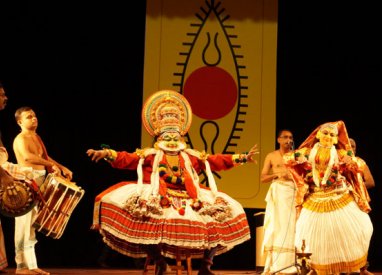 Kalamandalam Gopi The finale evening opened with a stunning performance by Guru Kalamandalam Gopi presenting ‘Rukmangada Charitam’. The opening was suitably delayed so that the Governor of Uttar Pradesh could arrive. He not only arrived late but also didn’t have the courtesy to take off his shoes when getting on stage to greet the artistes! Though everyone in the audience were given copies of the summary of the whole plot just before the performance began, the team manager Appukuttan Nair (Instead of that odd suit, why couldn’t he have dressed in Kerala’s traditional costume when he was being the spokesperson for such a legendary guru at such a prestigious gathering!?) suddenly decided to become an interpreter (more like an interrupter with his poor translations and funny accent). Thankfully, someone might have warned him and he withdrew his attempt and the rest of the show continued smoothly. As Kalamandalam Gopi performed the role of King Rukmangada wooing Mohini with the lines “Madhura thara komala vadane, madha sindhura gamane”, it was a sight to see the fine nuances of his style and technique. Just his portrayal of a graceful elephant in a repetitive loop was enough to keep everyone interested. Intensives 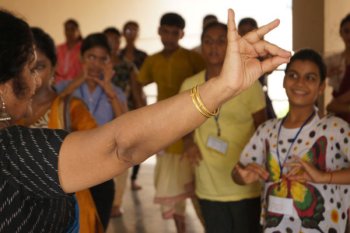 Chitra Visweswaran 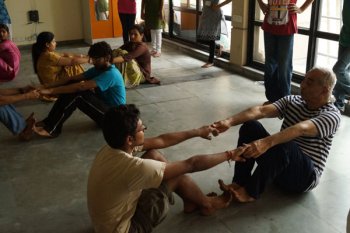 Astad Deboo Hundreds of participants were grouped into batches and sent to train under expert gurus for one week in what were called ‘Intensives.’ In Bharatanatyam, Guru Chitra Visweswaran and her two students, the wonderful Uma Namboodripad Satyanarayanan and Arupa Lahiri from Kolkata were teaching students basic footwork. The weeklong intensive under the guru’s guidance reflected in the wonderful program the students presented on the final day. In Kathak, Saswati Sen’s class of students were learning footwork and how to perform the famous ‘chakkars’ while another batch of students were under the watchful eyes of guru Malabika Mitra and her student Sourav Roy teaching, in yet another classroom, veteran Rani Karna and her two students were teaching their respective batch a hymn in praise of the Sun god. It was a breath of fresh air to see some contemporary dance amidst all the classical dancers. Astad Deboo was flexing his batch of students into movements they wouldn’t have possibly gotten their training anywhere else. On the final day, this batch stood out for its precision and excellence in the group presentations. Astad is a tough task master and an excellent teacher. SPIC MACAY should bring him more often to give participants a wider knowledge of the various genres of Indian dance. 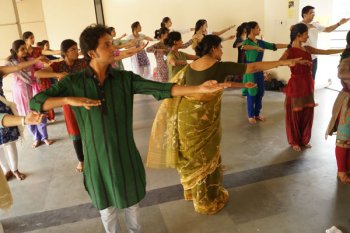 Malabika Mitra 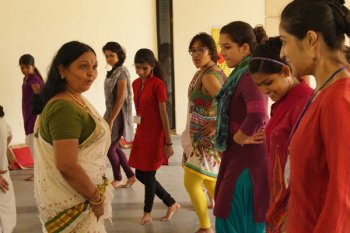 Kalamandalam Hymavathi 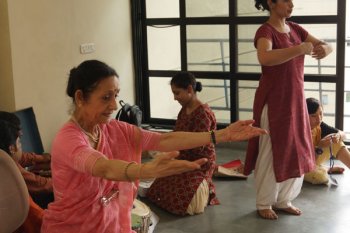 Rani Karnaa 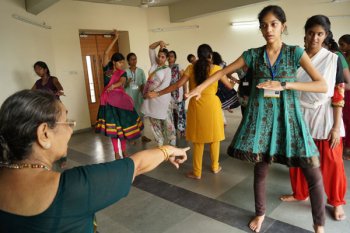 Uma Rama Rao In Odissi, we saw Sharmila Biswas training her batch of students to choreograph a hymn to the mother goddess slaying the demon Mahishasura. In Kuchipudi, veteran guru Uma Rama Rao was teaching her batch a Pushpanjali composed by Vedantam Prahalada Sarma in ragam Shankarabharanam. In Mohiniattam, Guru Kalamandalam Hymavathi was training her students to perform a Sollukattu. On the final day, each of these batches presented what they had learnt over their week-long training under all these gurus. The dance segment of the 1st international convention could have easily been a bit more improved than what was presented. It was surprising to see the complete absence of Bharatanatyam performance to represent at such a big convention. However, the saving grace was that the intensives had a large chunk of dance gurus and that helped many students to learn more. It was also refreshing to see some good contemporary dance. The 1st international convention was a grand success and a treat for all of us who attended it. Veejay Sai is a writer, editor and a culture critic. |